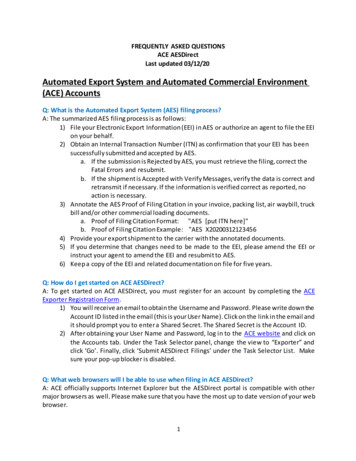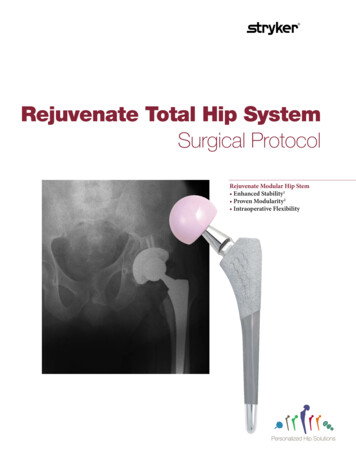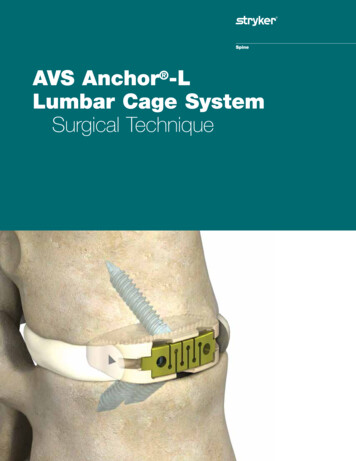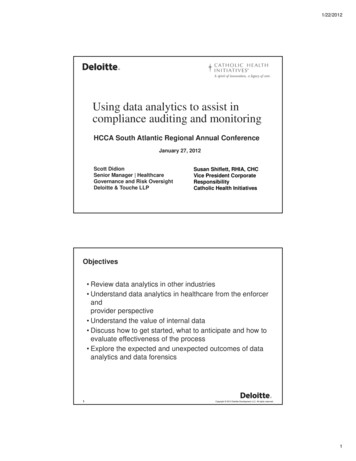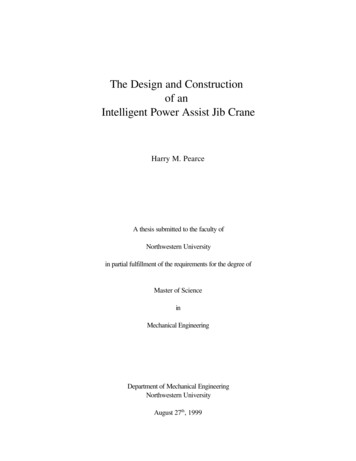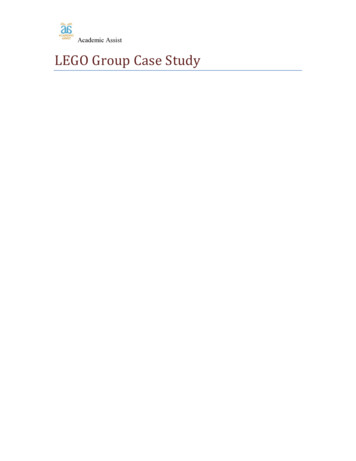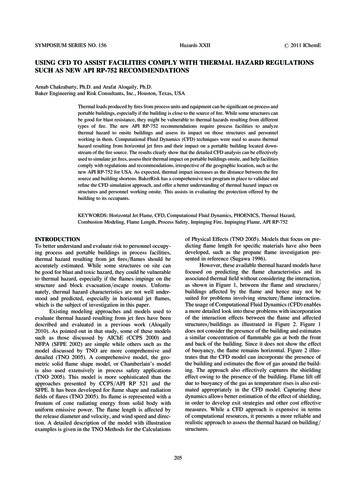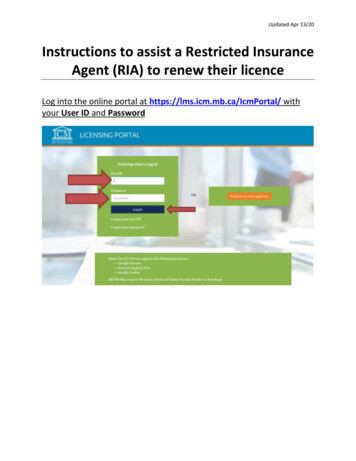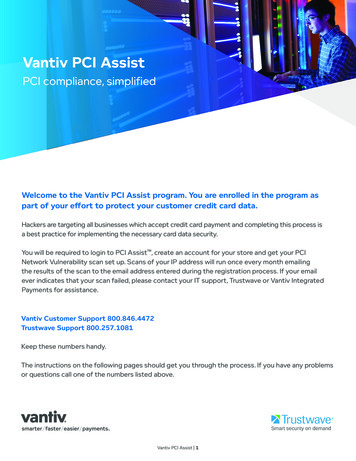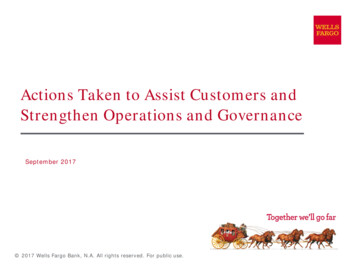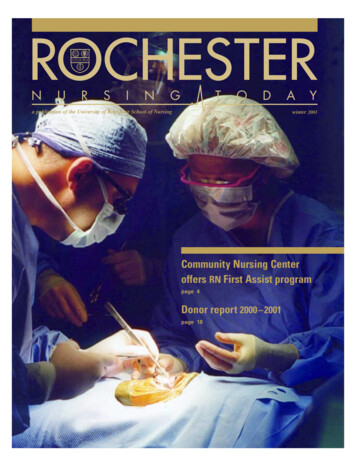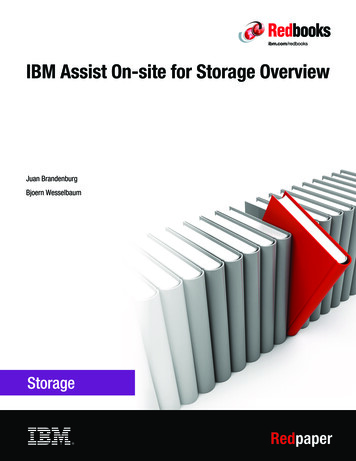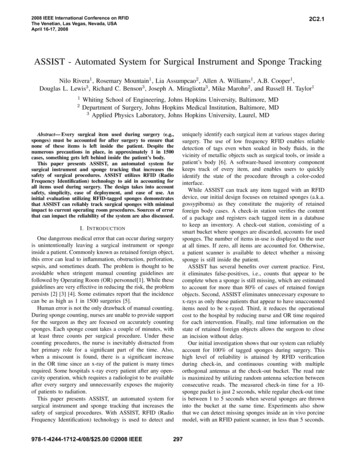
Transcription
2008 IEEE International Conference on RFIDThe Venetian, Las Vegas, Nevada, USAApril 16-17, 20082C2.1ASSIST - Automated System for Surgical Instrument and Sponge TrackingNilo Rivera1 , Rosemary Mountain1 , Lia Assumpcao2 , Allen A. Williams1 , A.B. Cooper1 ,Douglas L. Lewis3 , Richard C. Benson3 , Joseph A. Miragliotta3 , Mike Marohn2 , and Russell H. Taylor112Whiting School of Engineering, Johns Hopkins University, Baltimore, MDDepartment of Surgery, Johns Hopkins Medical Institution, Baltimore, MD3 Applied Physics Laboratory, Johns Hopkins University, Laurel, MDAbstract— Every surgical item used during surgery (e.g.,sponges) must be accounted for after surgery to ensure thatnone of these items is left inside the patient. Despite thenumerous precautions in place, in approximately 1 in 1500cases, something gets left behind inside the patient’s body.This paper presents ASSIST, an automated system forsurgical instrument and sponge tracking that increases thesafety of surgical procedures. ASSIST utilizes RFID (RadioFrequency Identification) technology to aid in accounting forall items used during surgery. The design takes into accountsafety, simplicity, ease of deployment, and ease of use. Aninitial evaluation utilizing RFID-tagged sponges demonstratesthat ASSIST can reliably track surgical sponges with minimalimpact to current operating room procedures. Sources of errorthat can impact the reliability of the system are also discussed.I. I NTRODUCTIONOne dangerous medical error that can occur during surgeryis unintentionally leaving a surgical instrument or spongeinside a patient. Commonly known as retained foreign object,this error can lead to inflammation, obstruction, perforation,sepsis, and sometimes death. The problem is thought to beavoidable when stringent manual counting guidelines arefollowed by Operating Room (OR) personnel[1]. While theseguidelines are very effective in reducing the risk, the problempersists [2] [3] [4]. Some estimates report that the incidencecan be as high as 1 in 1500 surgeries [5].Human error is not the only drawback of manual counting.During sponge counting, nurses are unable to provide supportfor the surgeon as they are focused on accurately countingsponges. Each sponge count takes a couple of minutes, withat least three counts per surgical procedure. Under thesecounting procedures, the nurse is inevitably distracted fromher primary role for a significant part of the time. Also,when a miscount is found, there is a significant increasein the OR time since an x-ray of the patient is many timesrequired. Some hospitals x-ray every patient after any opencavity operation, which requires a radiologist to be availableafter every surgery and unnecessarily exposes the majorityof patients to radiation.This paper presents ASSIST, an automated system forsurgical instrument and sponge tracking that increases thesafety of surgical procedures. With ASSIST, RFID (RadioFrequency Identification) technology is used to detect and978-1-4244-1712-4/08/ 25.00 2008 IEEEuniquely identify each surgical item at various stages duringsurgery. The use of low frequency RFID enables reliabledetection of tags even when soaked in body fluids, in thevicinity of metallic objects such as surgical tools, or inside apatient’s body [6]. A software-based inventory componentkeeps track of every item, and enables users to quicklyidentify the state of the procedure through a color-codedinterface.While ASSIST can track any item tagged with an RFIDdevice, our initial design focuses on retained sponges (a.k.a.gossypiboma) as they constitute the majority of retainedforeign body cases. A check-in station verifies the contentof a package and registers each tagged item in a databaseto keep an inventory. A check-out station, consisting of asmart bucket where sponges are discarded, accounts for usedsponges. The number of items in-use is displayed to the userat all times. If zero, all items are accounted for. Otherwise,a patient scanner is available to detect whether a missingsponge is still inside the patient.ASSIST has several benefits over current practice. First,it eliminates false-positives, i.e., counts that appear to becomplete when a sponge is still missing, which are estimatedto account for more than 80% of cases of retained foreignobjects. Second, ASSIST eliminates unnecessary exposure tox-rays as only those patients that appear to have unaccounteditems need to be x-rayed. Third, it reduces the operationalcost to the hospital by reducing nurse and OR time requiredfor each intervention. Finally, real time information on thestate of retained foreign objects allows the surgeon to closean incision without delay.Our initial investigation shows that our system can reliablyaccount for 100% of tagged sponges during surgery. Thishigh level of reliability is attained by RFID verificationduring check-in, and continuous counting with multipleorthogonal antennas at the check-out bucket. The read rateis maximized by utilizing random antenna selection betweenconsecutive reads. The measured check-in time for a 10sponge packet is just 2 seconds, while regular check-out timeis between 1 to 5 seconds when several sponges are throwninto the bucket at the same time. Experiments also showthat we can detect missing sponges inside an in vivo porcinemodel, with an RFID patient scanner, in less than 5 seconds.297
Fig. 1: Check-In StationFig. 2: Check-Out StationII. BACKGROUNDthat utilize a binary tree anticollision protocol as we needto account for every item before and after surgery with thehighest certainty.In healthcare, RFID has two major areas of application,administrative and direct-patient. Administrative applicationsinclude supply chain, smart shelving, and equipment and/orpharmaceuticals tracking. RFID technology is becoming wellestablished in these areas due to efficiencies established incommercial and industrial sectors. Direct-patient applications, on the other hand, are still in their infancy largelybecause they can have a direct impact on the patient’shealth. One example is VeriChip[7], approved by the FDA in2004, and offers implantable RFID chips containing personalmedical information to help limit medical treatment errors.ASSIST will also require FDA approval as it directly affectspatients’ health and safety.Two general variants of RFID technology exist; activetags, which require an internal power source, and passivetags, which rely on the incoming radio frequency signalto power up and respond to commands. Both tag systemsoperate in different frequencies; low, high, ultra high, and microwave. Low frequency (LF) tags work in the 125-148 KHzrange and utilize magnetic fields for communication. Theyare largely unaffected by the presence of fluids, non-ferrousmetals, and most electromagnetic (EM) noise sources. Highfrequency (HF) tags work at 13.56 MHz, can read somedistance through fluids, and are susceptible to noise andantenna detuning in the presence of metals. Higher frequencyRFID devices utilize electric fields for communication whichare attenuated by fluids and are therefore not suited fortracking fluid soaked sponges. Finally, there are two familiesof anticollision protocols: binary tree and Aloha. The binarytree provides a deterministic approach to read every availabletag, while Aloha derived protocols are purely stochastic andrely on probability to ensure that every tag is read.RFID is well suited for automating sponge counting in theOR. It allows us to uniquely identify each tag and reliablyaccount for each one during surgery. We chose passive tagsas they do not require an internal energy source, last muchlonger than active tags, can be made in much smaller sizes,and can be manufactured at a significantly lower cost. Lowfrequency tags enable us to search for items within a patientwith high reliability as organs, bones, and body fluids aretransparent to magnetic fields. In addition, we choose tagsIII. A PPROACHOur approach is to develop an electronic inventory thatcan keep track of every surgical item used during surgery.RFID is used for non-line-of-sight identification (a uniqueserial number for each sponge can be received by wirelessmeans). A check-in station, a check-out station, and a patientscanner are used by OR personnel to track and/or findsponges throughout the surgery. All of these components arecontrolled via a software system that utilizes a color-codedinterface for easy and fast assessment of the location of theitems during surgery.A. Check-in StationThe check-in station consists of two orthogonal RFIDantennas surmounted on top by a perpendicular UPC barcodereader. A design is depicted in Figure 1. The check-in stationis small, simple, and occupies very little space. The UPCbarcode identifies a package and the number of items withinit. Before accepting the package, ASSIST verifies that thepackage has the expected number of items in it, which isgathered from barcode information. If the package containsa bad RFID tag, the reader will recognize the discrepancy andsubsequently direct the removal of the package. In addition,the barcode provides us with a description of the type ofsponge associated with each RFID tag. Note that this barcodecan be easily replaced by an RFID-based Electronic ProductCode (EPC) [8].It is also possible to store the barcode information in theRFID tags already available inside the sponges. While thisis possible, it would increase the price of the tags as theywould require read/write memory to hold this informationinstead of just a unique read-only ID. In addition, spongemanufacturers would have to ensure that the RFID tags thatthey attach to the sponges are programmed with the correctinformation. Further, the same sponge may be packagedin different quantities, which requires different codes to beinserted in tags that are destined for different packages. Assuch, it is simpler to attach that information to the packagingmeans of a barcode or EPC.298
RFID tagged sponges inbar-coded packagingOfflineData-EntryCheck-in StationNoReject packageSurgical ItemsRegistry DatabaseValidCount?YesUpdate InventoryUse in SurgeryInventoryDatabaseRFID tagged spongeERROR!!!NLB UnreliableCheck-out StationNoChecked-in?YesUpdate InventoryFig. 3: Control Flow OverviewFig. 4: GUIWhen a package is accepted, every item is registered intothe system inventory where it can be tracked throughout thesurgery. As previously stated, each sponge is distinguishableby its RFID tag which has a unique serial number.the sponge is likely to be surrounded by bones (e.g., heartsurgery).A patient scanner can be used to detect, and somewhatlocalize, missing sponges in the patient. We use a blanketembedded with a large antenna that allows us to reach deeperinto the patient, increasing the chance of finding any missingsponge. Smaller antennas may also be embedded in theblanket to localize the missing sponge. Any sponge foundby the patient scanner is identified as ”In-Patient” in thesoftware inventory.While very convenient, some medical devices may reactinappropriately to the presence of an RFID patient scanner.For example, a recent study by the FDA [9] shows thatRFID can interfere with pacemakers and Implantable CardiacDefibrillators. These patients can still benefit from ASSISTaccurate inventory system, but must resolve to other meansof finding missing sponges when necessary (e.g., x-ray).B. Check-out StationA stainless-steel bucket, commonly known as a kickbucket, is the normal depository for used sponges in theOR. It is small, simple, and convenient. Our approach is toprovide a new kickbucket with a similar form factor, enablingthe OR to replace existing ones with minimum disruption.The ASSIST kickbucket is equipped with an RFID reader,five orthogonal antennas (four sides plus the bottom), and themeans to talk to the software component that keeps track ofthe inventory (i.e. wireless serial port). Since every RFIDtag is equipped with a unique serial number, no sponge iscounted more than once. A design is depicted in Figure 2.The ASSIST kickbucket continuously scans for spongesand updates the inventory accordingly. While 5 antennas mayseem excessive, our initial results suggest that we requireall of them to ensure that all the sponges are read reliablywithout any significant involvement from OR personnel.Further design refinement may result in a more economicaldesign, but such considerations are left for a subsequentdesign phase.Although the ASSIST kickbucket is intended for usethroughout the surgery, the OR staff can also use another,non-RFID equipped kickbucket to dispose sponges, andtransfer them all (possibly in a bag) into the ASSISTkickbucket at the end of the surgical procedure.C. Patient ScannerWhen a sponge is considered ”missing”, current practiceOR procedure dictates that an x-ray of the patient be taken.This requires an x-ray machine to be brought into the OR,or that the patient be moved to an x-ray equipped location.A radiologist needs to be called to read the x-ray. The x-raymay not reveal the missing sponge, especially in cases whereD. Software SystemIt is routine for most OR facilities to utilize computermonitors during surgical procedures. Our approach is toincorporate our inventory software-based approach with thecurrent OR computer infrastructure. In general, the softwaresystem should be multi-layered, extensible, and fault tolerant,enforcing when possible the policies in place to ensurecompliance with the new procedure.ASSIST uses two databases; the surgical items registry,and the inventory. The registry contains barcode informationfor each package (i.e. description, quantity). The inventorykeeps track of all items that have been checked-in as theypass through the system and makes sure that every item isaccounted for after the surgery is complete. Any missingitem will be reflected in the inventory, at which time thepatient must be scanned by the patient scanner and/or x-ray.An overview of the different databases and the flow of theprocedure is shown in Figure 3.The Gra
detection of tags even when soaked in body fluids, in the vicinity of metallic objects such as surgical tools, or inside a patient’s body [6]. A software-based inventory component keeps track of every item, and enables users to quickly identify the state of the procedure through a color-coded interface. While ASSIST can track any item tagged with an RFID device, our initial design focuses o
